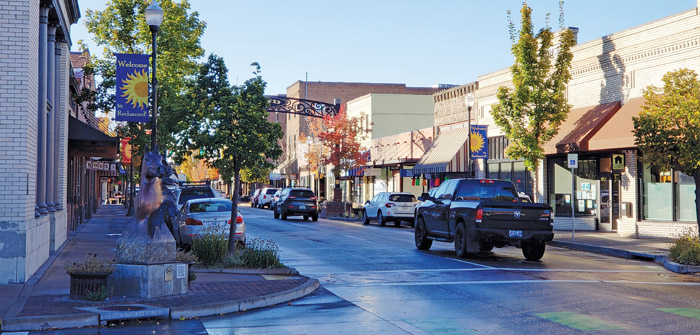(Several new businesses open downtown in 2022 | Photo by Bruce Barrett)
Unemployment hovers at record low levels in Deschutes County as the weather turns to Fall but a major war in Europe, a recent pandemic that dumped billions of dollars of stimulus money into the economy and record consumer demand have combined to create the largest inflation spike in 40 years and has rapidly increased the costs to borrow money. But the region’s commercial real estate sales in 2022 defy these gloomy financial realities.
Ken Sinclair, vice president commercial relationship manager of Umpqua Bank, says, “Regarding today’s market environment, inflation and talk of the “R” word, Umpqua is definitely taking a closer look at factors such as the tenant’s longevity and industry type, the owner’s financial strength and overall credit quality of the property. That being said, we here in central Oregon are still seeing strong demand for commercial property due to population growth and limited inventory.”
Impact of Population Growth
Recent population forecasts indicate that Deschutes County is expected to add another 50,000 residents in the next ten years. According to recent census data, Deschutes County has grown twice as fast as the rest of the State. Currently Deschutes, Crook and Jefferson Counties are among the top five fastest-growing Counties in Oregon. However, rapid growth comes at a cost. Population growth places more stress on available resources and it is generally acknowledged that there is a shortage of available space for new business. Retail and office space vacancy in Bend and Redmond is around 3% and Industrial vacancy is less than 1%.
The demand for available space makes it less affordable for expanding businesses. Many business owners are seeing rapidly increasing lease rates in Bend, and in the new commercial developments located in Northwest Crossing and the Old Mill District. New buildings demand premium lease rates. Many business owners are considering expansion through satellite locations in more modestly priced locations like Redmond, Prineville and Madras. This expansion often must be financed through local lenders.
Impact of Higher Financing Costs
As the fed funds rate changes, so do the interest rates that lenders charge borrowers, including interest on business loans. Most recently, the Federal Reserve raised its target range for the fed funds rate by 75 basis points to 2.25%-2.5% during its July 2022 meeting. It was the fourth consecutive rate hike and pushed borrowing costs to the highest level since 2019. Local lenders add their margin of, say, 4% to their funds rate making the current market rate over 6%.
Jacob Mayhill, commercial loan relationship officer, MidOregon Credit Union, addresses how increased loan rates and inflation changes his view of prospective borrowers: “We have not tightened our lending standards, but we are finding it more challenging for borrowers to meet the same lending standards in this market where prices and interest rates are higher.”
The National Association of Realtors (NAR) released an analysis that said cap rates were likely to keep compressing in 2022 despite rising interest rates.
Although typically rising interest rates would push up mortgage costs, creating downward pressure on property prices, that may not be the case, at least for now. There are other factors like abundant 1031 funds flowing into Central Oregon and the strong demand from new or expanding businesses that keep pushing up prices and, in turn, further compress cap rates.
“As of 2022 Q1, National office real estate prices are up 10% year-over-year on average while prices of retail real estate are up 16%. Industrial properties experienced the strongest price gain of 30% followed by apartment assets at 22%,” as the NAR noted.
Mayhill explains how his credit union sees a prospective borrower: “In a post-COVID market with tighter cap rates and rising costs we sometimes need to be creative with borrowers. It starts with taking a relationship approach by listening to our borrowers and working to understand who they are, the road they’ve traveled and where they’re heading. This helps us understand all the options for financing. We interweave this approach with our responsibility to our credit union members and our federal regulators at the NCUA to make good loan decisions.”
Ken Sinclair describes his bank’s challenges: “Today’s market rates are really a fluid situation. With impending rate hikes around every corner by the Fed and the inverted yield curve, what was the norm six months ago is no more. We try to focus on the entire client relationship (depository, treasury management, wealth investment, etc.) to win the client’s business.”
Other Factors Impacting CRE
Other factors that create shortages of commercial real estate in Central Oregon include Oregon’s restrictive land use laws and land use activists who present legal challenges to development. In addition, cities and counties are struggling to process the increased development applications.
Considering the recent changes and challenges to commercial property owners and users, recent data from the Central Oregon Association of Realtors’ MLS listing report comparing year-to-date 2021 and 2022 shows an 18% decline in total commercial sales but with a 10% increase in total volume at over $190,850,000. This makes sense in light of the limited availability and increasing prices.
The Future is Bright for CRE
Many economists and financial analysts expect interest rates to level out in 2023 and local CRE experts expect continued high demand due to growth and unmet needs. More projects are in the pipeline as developers and investors are rallying to the need.




